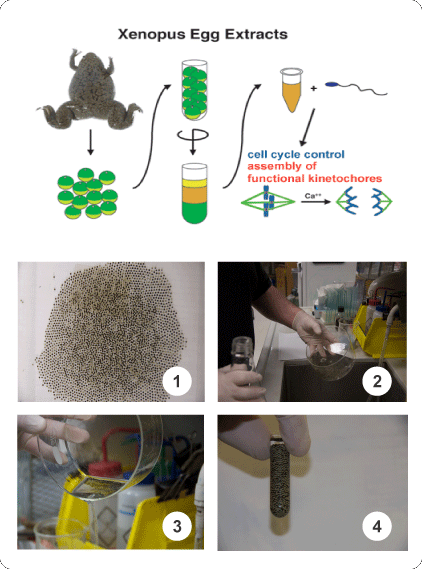| Experimental Systems | |
 |
We use a wide variety of experimental systems. In addition to various cell cultures, we use a frog egg extract system to study the mitotic spindle in vitro. We induce female frogs (Xenopus laevis) to lay eggs, then collect the eggs and crush them in a centrifuge. This produces egg extract, which we can manipulate in a variety of ways to produce mitotic spindles.
1. Freshly laid eggs
2. Egg washing
3. Removal of jelly coat
4. Packing before crushing spin |
| About Our Microscopes We use optical microscopy as one of our primary analytical tools for live cell and fixed cell analysis. In our lab we maintain several scopes, housed in the fabulous Russian Tea Room, that are designed for a variety of applications. |
|
 |
Ivan the Terrible Ivan is a deconvolution and image restoration microscope built on an Olympus IX70 stand. It uses an Applied Precision stage and DeltaVision software for 3 and 4D image acquisition and restoration. |
 |
Vlad the Impaler Vlad is a Nikon TE-2000E stand built for live cell fluorescence time lapse, photobleaching and photoactivation studies. Vlad uses a Yokogawa spinning disk confocal for acquisition coupled to an 8-line laser launch and an EMCCD camera. Yes we know Vlad wasn’t Russian but being the real-life Dracula earned him some points. |
 |
Krupskaia Krupskaia is an upright Nikon Eclipse 80i stand with oversized violet corrected objectives the size of baseball bats. A workhorse scope for the lab and the wife of Lenin she is an overall lovely lady. |
 |
Rasputin Rasputin is built on a Nikon Eclipse Ti stand that is a shared system between the Spudich, Pfeffer, Rohatgi and Straight labs that was made possible through the NIH S10 program. Rasputin is equipped with a Digital Mosaic patterned photobleaching/photoactivation system and TIRF illumination optics. Using dual EMCCD cameras and an optical path splitter enables us to perform simultaneous dual wavelength acquisition for ratio imaging studies. |





